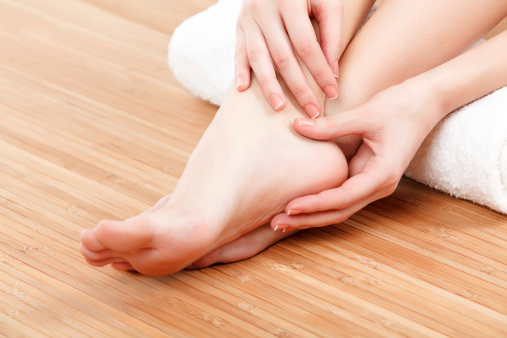
The feet are probably the most underrated part of the body when it comes to overall health. People are not really reminded of them until they have a fungal infection, feel itchy and get blisters. But the truth is that the feet can tell you a lot what’s going on in your body – from serious illnesses such as diabetes to any less problematic such as nutritional deficiencies and dehydration. After all, each foot has 33 joints, 100 tendons, muscles, as well as many nerves and blood vessels than go to the heart, brain and spine.
Don’t dismiss the pain in your feet thinking that you’re just tired. They are a lot more than just the base of your entire body that moved you from one location to another. Pay attention to how they look and, especially how they feel, if you want to catch potentially deadly diseases as soon as possible. They may be farthest from the heart and thus being last in getting fresh blood, but they are the first to show is you have problems with blood circulation.
Extremely dry feet
It could be just dry skin which is typical in the winter but it could also be poor blood circulation due to peripheral arterial disease, which about 8 million people in the U.S. have. Other signs include hair growing on the feet or ankles as well as shiny skin. The arteries harden as a result of plaque building up in them. Very dry skin can also be a sign of other problems such as athlete’s foot or even an allergic reaction. If you have diabetes and your feet get very dry, you may have an autonomic neuropathy, which is when the nerves that go from the brain to the heart are damaged.
A lot of cramps
The usual cause is dehydration but it could also be lack of magnesium, which is crucial for at least 300 bodily functions, or of calcium or potassium. Nutrient deficiency can be serious. Make sure you get enough minerals every day in your body. Drink enough water during the day. Milk, which is the best source of calcium, is a good drink, too.
Cold feet
If your feet are cold all the time, your thyroid may not be working properly – it may not be producing enough hormones to regulate your metabolism (hypothyroidism). Your body’s ability to generate heat is affected and that’s why your hands and feet are always cold. Other side effects are fatigue, weight gain and possibly hair loss.
Sores and cuts don’t heal
This may be a sign of diabetes. Sores that won’t heal are a signal for poor blood circulation, which is one of the symptoms of the disease. Increase blood sugar levels can cause nerve damage stopping enough blood from reaching the feet. That’s why the skin doesn’t heal. Unhealed scrapes are basically open wounds that can lead to infections and possibly amputation.
Unusually big toe
The cause is likely gout, which is a very painful form of arthritis. It’s caused by certain foods that contain a lot of purine. It’s found in red meats, fish and some kinds of alcohol. The chemical raises the levels of uric acid so high that sharp crystals accumulate in the joints.
Tingling or numbness
The pins and needles you’re feeling in your feet may be another sign of diabetes. Decreased sensation can also be a sign of peripheral neuropathy, which is another indication of diabetes because lots of sugar in your blood stops the nerves from functioning properly. A nerve along the side of the foot stretches and eventually gets crushed which is why you lose sensation there.
Losing hair on your toes
The problem could be poor blood circulation resulting in hair follicles not being able to stay intact. This is typical for vascular disease, usually arterial sclerosis. This is when the arteries that bring blood from the heart to the extremities harden.
Rounder and wider toes
This can be a serious sign of lung cancer or heart issue because they reduce blood flow to the small arteries in the toenails. The tissue swells which leads to what is called “digital clubbing,” which basically means toes that are rounder and wider. Another cause of clubbing can be an intestinal illness. Neuropathy also can be an indication of lung cancer.
High arch
This is a sign of an underlying neuromuscular condition. A common type is Charcot-Marie-Tooth, when the peripheral nerves are damaged, leading to changes in the gait, as well as numbness and loss of muscle.
Yellow toenails
The change of color is usually the cause of mild fungus. However, it can sometimes be brought by respiratory problems and lymphedema, which causes fluid retention, leading to swelling in the arms or legs.
Swollen ankles
Swollen ankles happen so often that people think it’s just because they walked a lot and disregard the sign. However, it could mean something a lot more serious such as kidney problems. Their job is to filter nutrients. But if they don’t work well, the body retains fluid and it builds up all over, especially in the ankles and feet because we are standing a lot.
Red lines under the toenails
If you see a red line, think the heart. Red lines can be a sign of a heart infection. Blood vessels can be broken as a result of small blood clots damaging the capillaries under the nails. They can be an indication of endocarditis, an infection of the heart’s inner lining. It can cause heart failure if left untreated.
Pitted toenails
Pitted toenails are likely a sign of psoriasis, a common chronic condition of the skin. A lot of people with this condition have tiny little holes in the finger and toenails. The nails can also appear to be yellow or brown. If you see any ridges or grooves in your toenails, check them out.
Source :- MSN.com

Leave a Reply